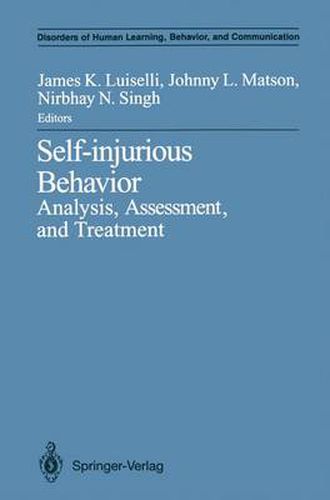Readings Newsletter
Become a Readings Member to make your shopping experience even easier.
Sign in or sign up for free!
You’re not far away from qualifying for FREE standard shipping within Australia
You’ve qualified for FREE standard shipping within Australia
The cart is loading…






This title is printed to order. This book may have been self-published. If so, we cannot guarantee the quality of the content. In the main most books will have gone through the editing process however some may not. We therefore suggest that you be aware of this before ordering this book. If in doubt check either the author or publisher’s details as we are unable to accept any returns unless they are faulty. Please contact us if you have any questions.
This volume addresses the topic of self-injurious behavior (SIB) in per sons with developmental disabilities. Among professionals and the lay public alike, there is little debate over the seriousness of self-injury, its detrimental effects, and the need for therapeutic intervention. At the same time, there are divergent views concerning its etiology and treat ment. Understanding the causes of self-injury, for example, requires an analysis of biological factors, socioenvironmental variables, communica tion competencies, and in complex clinical cases, the interrelationships among these influences. There is also uncertainty with regard to the function of self-injury. Put simply, why would people willingly inflict injury upon themselves? Finally, although there is little disagreement about the necessity to intervene for self-injury, clinicians do not make uniform therapeutic recommendations, and, in fact, considerable dif ferences in treatment selection are common. This fact is most apparent when one considers the ongoing controversy with regard to aversive and nonaversive programming. Our premise for this volume is that a greater understanding of self injurious behavior is dependent upon an empirical research base. Theories of causality must be conceptually valid and capable of being evaluated objectively. Treatment must be functionally determined, operationalized, and replicable across personnel and settings. For these reasons, we have assembled chapters by individuals who are experi enced clinicians and researchers in the fields of psychology, medicine, psychiatry, education, psychopharmacology, and developmental dis abilities.
$9.00 standard shipping within Australia
FREE standard shipping within Australia for orders over $100.00
Express & International shipping calculated at checkout
Stock availability can be subject to change without notice. We recommend calling the shop or contacting our online team to check availability of low stock items. Please see our Shopping Online page for more details.
This title is printed to order. This book may have been self-published. If so, we cannot guarantee the quality of the content. In the main most books will have gone through the editing process however some may not. We therefore suggest that you be aware of this before ordering this book. If in doubt check either the author or publisher’s details as we are unable to accept any returns unless they are faulty. Please contact us if you have any questions.
This volume addresses the topic of self-injurious behavior (SIB) in per sons with developmental disabilities. Among professionals and the lay public alike, there is little debate over the seriousness of self-injury, its detrimental effects, and the need for therapeutic intervention. At the same time, there are divergent views concerning its etiology and treat ment. Understanding the causes of self-injury, for example, requires an analysis of biological factors, socioenvironmental variables, communica tion competencies, and in complex clinical cases, the interrelationships among these influences. There is also uncertainty with regard to the function of self-injury. Put simply, why would people willingly inflict injury upon themselves? Finally, although there is little disagreement about the necessity to intervene for self-injury, clinicians do not make uniform therapeutic recommendations, and, in fact, considerable dif ferences in treatment selection are common. This fact is most apparent when one considers the ongoing controversy with regard to aversive and nonaversive programming. Our premise for this volume is that a greater understanding of self injurious behavior is dependent upon an empirical research base. Theories of causality must be conceptually valid and capable of being evaluated objectively. Treatment must be functionally determined, operationalized, and replicable across personnel and settings. For these reasons, we have assembled chapters by individuals who are experi enced clinicians and researchers in the fields of psychology, medicine, psychiatry, education, psychopharmacology, and developmental dis abilities.